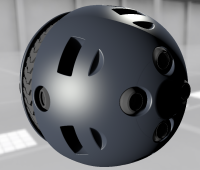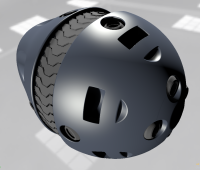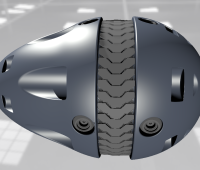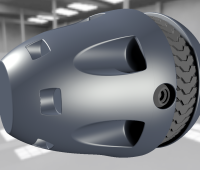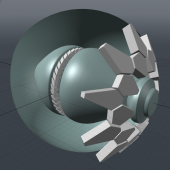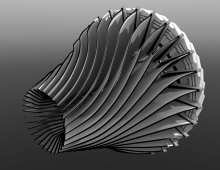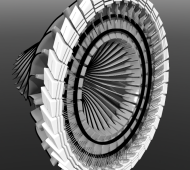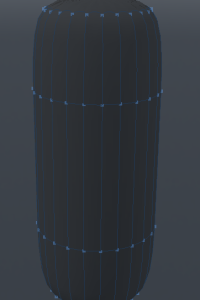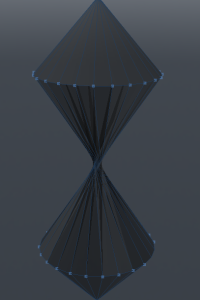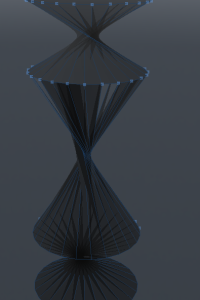Sidebar
Table of Contents
LA/AN063 G-Series Attenuated Aetheric powerplant
The AN063 is an aetheric powerplant. Unusually, it uses carrier-particles instead of electromagnetic trickery to produce its aether-tap. In order to do so, it must extract said particles from a fuel source, usually matter - producing positrons (a form of antimatter) in the process as a waste product.
The powerplant is essentially a lobotomised version of the Occhestran schematic 'Aurora'. It entered the market in YE 36.
History
Believing that only aetheric sovereigns were taken seriously in the interstellar political sphere, the move was made to begin developing a platform of their own. Not only would it serve to ensure they would be respected (and perhaps even feared) but it would also grant the matriarchy the means to defend themselves from NMX attack (lessening their dependence on larger nations).
Money and resources were difficult to move due however since if Yamataian intelligence caught wind of this, at best it would be difficult to explain and at worst could lead to a pre-emptive strike by Yamatai.
In YE 28, the LSDF's matriarchy armour works dug up the Aurora something at the time viewed as a scientific novelty at best and attempted to overcome its instabilities, often with catastrophic results.
YE 31, the work and funding would be passed onto a small think-tank of just four members who suggested a computable approach rather than a brute-force approach would be the solution: that through intelligently regulating the device instead of using tremendously massive hardware would be the solution. With time, this organisation would eventually fruit into the beginnings of the Lazarus Consortium.
The design problem was eventually cracked using genetic/evolutionary design that is, massively parallel simulation with iterative changes, throwing literally everything against the wall to see what would stick - and then studying the adaptations which did stick to produce a useful product. The title AN063 is the iteration which resulted in the base-layout of the device.
Nearly a decade later, the end result was ready for production. While in many ways it was radically and lobotomised, it was now a safe and usable power-source.
It is believed the existence of the device would tip the balance in Lorath/Nepleslian negotiations - with aetheric potential giving the Matriarchy the firm punch it would need to appear a strong enough partner to Nepleslia - though the device was not 'officially' completed until well after the negotiations had been established.
General
Class: Powerplant Nomenclature: LA/AN063 G-[model-number] Designers: Unknown Manufacturer: Lazarus Consortium Users of this product: Lorath Self Defense Force, Lazarus Consortium
Known Accessories
Appearance
The device itself varies tremendously in size, though its core components in almost all implementations are the same: a double-egg shaped half-ellipsoid turbine assembly. Often, many of these devices are networked together in shapes resembling what is described in engineering terms as a 'brain gear'.
Key in its core construction are the fly-wheels and stabilisers: rings built into the turbine assembly. The casing is usually spherical in shape, armoured and smooth featuring fitting-locks, inlets, outlets and data control ports. Importantly, the shell is scalar-shielded and sealed shut. Importantly, it features scalar-shielded explosive release bolts and retrothrusters and an emergency, it is expected the device is to be purged.
Operational Usage
The AN063 has a variable output which can be throttled up or down based on need, altering the fuel consumption and output product and energy production. The second stage aetheric component can also be disengaged to remove the unit's aetheric sensor signature, though this limits the output of the powerplant drastically and is not ideal for combat operation (and should instead be likened to silent running).
Ignition
Fuel is important during the ignition phase since the powerplant requires baryons (matter) to break down and establish the aeons that make the main conductor of the aetheric-tap. If a bare minimum of baryons or aeons isn't available, the powerplant cannot start. Normally, two reserve tanks are stored which carry enough for an emergency start and then immediately moving into forced recovery mode.
Fuel
The first stage of the AN063 runs on baryons, almost any form of matter available (ideally in a liquid form - water, hydrogen and nitrogen being common fuels). A pre-processor is available however to blend hard-solids into a form which can then be used. For this reason, cooling and fuel tend to be much more forgiving concerns in atmosphere than in deep space.
Recovery Mode
Provided the attenuator component of the powerplant is running, fuel can be restored by using an onboard aether to matter device (at a very slow and sustainable rate) to restore more fuel than the device is currently using, allowing it to replenish its supplies over time.
Unfortunately, in this mode of operation the device cannot power anything more than emergency systems.
Operation
During normal operation, the main conductor (a net of aeons to catch aether) is constantly being expanded and compressed like a lung or the compression cylinders of an engine. The number of cycles a second is very important, as is the volume of each 'breath'.
Throttling
When the AN063 is throttled up in output, an audible revving sound is usually played in the HUD as a representation of what the powerplant is doing with pitch and key corresponding to output and detected changes.
As a sensor
The main conductor is in competition with other aetheric taps. By comparing the return expected verses return received, the characteristics of aether interdiction and aetheric taps can be detected. The greater the draw of an aetheric tap or generator, the more easily it is detected. While theoretically its range could be infinite, the current hardware and software limitations present allows for very short range sensing capabilities.
In practical application, the use of the device as a sensor is able to be explained as a monitoring of disturbances in the aether caused by a tap. If there is a lone tap in an area within sensing range, then the ability for the tap to be identified and tracked would be considerably simple. However, if attempting to detect one tap amongst many, such as in a developed star system where numerous taps are being used by ship traffic and planetary operations, then sensor resolution would plummet drastically. Ranges expected in 'heavy' clutter could be as short as one kilometer. However, in expanses of space in which no other taps are in effect aside from one, that single tap would be able to be detected with relative ease.
Maximum Range With Interference (Developed star systems, high traffic areas): .5 to 2km Optimal Conditions: 25km
Erosion
As the temperature of the main conductor approaches critical levels (when the powerplant is beginning to peak or climax, usually to fire weapons), the main conductor is eroded and as such, the ignition sequences and recovery sequences need to be bled in to restore the main conductor's supply of aeons.
This means if weapons are used too aggressively and time isn't given for recovery, the AN063 can potentially run out of fuel or deliberately stall.
Approximate performance
The main elements of the AN063 can be used on a full variety of platforms, rather than being scaled up or down for a powerplant - generally with more units being used in parallel for fuel efficiency reasons.
To better explain: As the output is scaled up, the demands for cooling, fuel input and fly-wheel drift recovery rise enormously as does the scale, weight and cost of these components. So while the core of the powerplant might be identical on both an armour and a frame, these components will obviously be massively different and performance adjusted accordingly.
For example, what may be the maximum number of cycles a second a power-armour can handle may only be 35% of what a frame can handle since it is a larger and more robust platform with more room for these elements and their demands.
Over-throttling
These system limitations can be bypassed for a short time (equivalent to over clocking or over-throttling in this case) the powerplant by disengaging onboard limiters. This renders the unit employing the powerplant less fuel-efficient, less stable and more prone to drifting, overheating, stalls and needing recovery.
Systems Matching
Multiple powerplants can be linked together, acting as a Master/Slave pair in order to synchronise the wavelengths of the aeons. If they are not synchronised, aeons from both sources cannot be used together as they will repel one another: They will be unable to form a main conductor together and their aeons will repel each other (potentially explosively) causing great trouble storing them. To this end, larger units may feature many devices acting in a hub together as the main powerplant.
This linkage process is referred to as matching.
Fixed chased-matching
The default mode: If one device is leading and another is chasing: Generally in most cases, two devices are assigned a master slave relationship. Many slaves can be assigned but a master cannot become subordinate to a slave or another master unless its main conductor is larger (giving rise to higherarchy). If the two fall out of sequence, the slave must be resynchronised. If the master fails, the slave will no longer function as a slave and must be used as an alternative master with reduced output.
Relative Counter Matching
If both devices are attempting to copy each other’s tempo, they swing past and oscillate. They will countermatch and over-compensate, like the pendulum of a block, never meeting in the middle. Many more can be added but this slows the swings of the pendulum and makes individual cycles take longer. While more can be taken inside intake action, there will be less intakes happening and a much lower oscillation tolerance range. Output is additive but linked over distance. Ideal for starship use.
Oscillation estimation matching
Multiple devices are attempting not to copy each other’s tempo directly using an estimated position of what that tempo is going to be rather than reacting based on what is actually happening. Statistically is doomed to enter a deep and potentially unrecoverable state of drift after several minutes of stability. During this mode of operation, the output is however extremely high. Ideal for large weapons systems such as aether and shock cannons.
Known Absolute matching
Entirely hypothetical: Two identical devices with linked destiny (that is, they are composed of the same stuff or have been one another at some point, normally only really possible with time travel or some quantum strangeness) are absolutely and perfectly matched since all past outputs can be known precisely. Technically impossible within the bounds of our own universe. The volume of the main conductor is cubed.
The only known case of Known Absolute Matching was performed by Tai Shiro using the original Aurora device.
How she achieved it remains unknown.
Mechanics
The AN063 is a two stage powerplant, meaning for it to work two things have to happen: First, fuel must be broken down into components such as aeons, resulting in an electrical output comparable to most fusion powerplants of similar size. When enough aeons are available, the main conductor is formed which serves as the aetheric tap of the powerplant.
Based on how many aeons are available and the functional requirements of the powerplant, the topology, shape and size of the tap can be varied tremendously since it is formed from carrier particles rather than being a solid hardened component as it is in conventional aether powerplants.
Stage 1: Matter into components - Converter
In this stage, the nucleus of an atom is broken up into sub-components using monopoles to accelerate the natural process of baryonic decay - in order to prepare aeons for the main conductor of the attenuator.
Physics
The AN063's decay chamber works by coupling matter with monopoles. The resulting and complete instant destruction of the nucleus (via catalysed baryonic decay) releases muons, positrons (antimatter) and an exotic particle.
If the positrons and muons aren't captured for repurposing, they decay further into gamma radiation, which enters the gamma-voltaic outer-walls, giving rise to an electrical charge.
The exotic particle however is the famous carrier of aetheric charge which exists in aetheric reactors and weapons. Strangely, it is stabilized by the decay of the atom and continues to exist long after the charge itself has vanished. Its charge is captured, bled off through similar means as most aether powerplant systems - but the particle is stored for later use.
Elements of the process
Natural baryonic decay
Baryon is merely a catch-all term for physical matter, which decays naturally. This decay can take a tremendously long time (often longer than the universe is theorised to ever exist). Under the crushing stresses of a monopole however, this process can be hugely accelerated without loss to the monopole itself catalysed, if you will billions and billions of years of decay taking as little as a few seconds.
What is a monopole?
Until recently, very little was known about monopoles, since they can only be found in the hearts of super giant stars during their formulative states and in the liquid cores of some gas giants under tremendous electromagnetic stresses that would crush even the most capable of defensive barriers in existence today, making them supremely difficult to recover.
To clarify: most atoms are diapolar that is, they posess a 'north' and a 'south' pole or positive and negative charge directions, which attract one another and repel themselves. Electromagnetic fields flow in the shape of these charge directions, forming the familiar onion layers of flow, from the north into the south with iron filings the rotary vortex of a magnet, responsible for driving a motor under charge.
A monopolar atom however is strange: It possesses only a single pole - a single charge direction: electromagnetic fields can only be pushed away from it. This of course, includes atoms. If this action is used in such a way to crush an atom, it speeds up the process of an atoms natural decay since it is under stress.
Comparing to other nuclear technologies
To compare the energy release, one must examine existing nuclear technologies: fission and fusion.
Fission splits an atom to release energy which can be thought of as burning wood to release its stored potential. This of course comes at the cost of possibly burning whatever the fire is held in, should it get hot enough.
Fusion on the other hand bonds atoms together wastefully, releasing energy which can be thought of as rubbing wood together at such tremendous speeds that it becomes sticky like glue and bonds, though it releases heat and light in the process.
Baryonic decay destroys the complete atom to release ALL of its energy potential. This would be akin to burning wood but producing no left-over waste products or smoke: Only heat and light and nothing else, making it incredibly efficient but also incredibly dangerous.
The process
Classically, the Aurora on which the AN063 is based would pipe in matter or have it pre-stored and allow the monopole to accelerate its decay from the outside in, not unlike burning coal. This unfortunately resulted in a feedback loop from the electromagnetic release of gamma radiation and the unrestrained monopoles - making the process exponentially increase catastrophically or if managed, it would be unable to ever stop as the reaction would not start again.
New technologies allow AN063 to take a cyclic approach with separate timed steps not unlike an engine, with many steps rather than a fluid process for safety reasons. The first step is piping in matter to the reaction chamber. Second, the monopole is used in a 'flash' of action. Third, products are removed from the reaction chamber and then the cycle begins anew. The rate of cycles and their input perameters can be varied but once the process is stopped, it can no longer continue.
The number of cycles per minute can be raised to recover a higher output of pions, muons, positrons, bosons and base electrical charge conventionally whereas the amount of reactant in each cycle can be raised to populate each cycles gauge-bosons with a higher charge potential. The maximum charge potential is dictated by the scale of the reactor itself.
In this way, the reactor can produce energy in two ways: either by 'burning' matter or aetherically as a side-effect of the process, switching between the two methods as needed.
Noteworthy is that most methods of aetheric detection rely on the production of new gauge-bosons - for example, recognising the buildup prior to a weapon firing. By storing them long term, no such build-up is detected provided the reactor is in low output mode.
Physically speaking, the AN063 executes to complete synchronized cycles - one on each half, with propagation and capture waves resembling a leapfrogging bubble-ring on each half - mirrored, back to back. For this reason, the averaged reaction of both is usually indicated as a loop of changing size in a HUD or reactor readout while the influence of the monopole itself is usually represented as a torus of an electromagnetic field - which usually meets, repels itself around its outer-edge and then spreads on an inclined spiral.
Reaction products
Decay products & Chains
A number of products produced by the reaction very rapidly decay down into gamma radiation which is recovered by the gammavoltaic systems into usable electrisity. Electromagnetic coupling used to power the voracities of the monopole however allow these to be captured and stored for prolonged periods of time to do useful work.
Positron
Produced from the collapsing proton, positrons are anti-electrons, a common component in antimatter reactions and antimatter systems. Properly recovered, they can be re-used. If they are not recovered, they decay into gamma radiation.
Pion
Commonly tied to the nuclear strong-force which holds atoms together in conjunction with gluons. Very rapidly decays into muons & anti-muons.
Muon pair
The decay product of a pion, a muon pair can be used in muon-catylized nuclear fusion, drastically reducing the temperature needed in order to force nuclear fusion to take place. They decay into gamma radiation.
Aeons
Also known as the carriers of aetheric force. The heart of the attenuator.
Converter Components
The converter is composed of a fairly simple number of components and importantly, is not designed to be crew serviceable due to the highly dangerous nature of the monopole catalysts present in the decay chamber.
Fuel input & Fuel injection systems
Used to pull water or whatever liquid fuel is available to the powerplant. Contains a simple variable speed induction pump and is only used when more products are required.
Decay chamber
The heart of the converter, the decay chamber is lined with monopoles on extended antennae with catalyse the decay of whatever matter enters the chamber, converting it into products and gamma radiation. Understandably, the outer walls of the decay chamber are coated with a thin layer of zesuaium to prevent gamma radiation from escaping the chamber. The closer the catalysts are extended to the centre, the faster the rate of reaction, allowing the converter to be throttled.
Gamma-voltaic pickups
Sat along the inner walls of the decay chamber, quasicrystalline pickups convert the gamma radiation released into usable electricity to power the other systems of the powerplant and the systems of whatever unit the AN063 is mounted to.
Filtration systems
Uses a rotational centrifuge system and penning traps to separate out the different products and recover them, passing them for transmission or in the case of the aeon, off into the attenuator to form the main conductor.
Aether to matter converter
Not included with all models, the aether to matter converter is included to convert the charge recovered by the attenuator into fuel for the converter to keep the system running.
Stage 2: Attenuator: aeons to aether
At this stage, the aeons are arranged into a lattice called the main conductor which acts as an aetheric tap. Importantly, its shape can be altered and the pressure of extraction is not always constant like a pump but cyclic like an engine.
Aether 101
In much the same way light is carried or transmitted using a class of bosons known as photons, aether too is carried and transmitted by a class of bosons known as aeons. Like how light interacts with electrons (giving rise to electromagnetism), aeons can interact with photons and also gravitons (the carrier particle of gravity).
In a nutshell, the aether tap is a pump which uses aeons as a circuit. This circuit plugs into a higher dimension of space where aeons are commonplace and rich with charge potential. The charge potential is then pumped out through a process similar to osmosis and made to do useful work.
Sometimes this work is as a weapon — since charged aeons destabilise nuclei in atoms and utterly destroy matter in the most literal sense. Sometimes it is used as a propulsion system using the gravitational interactions.
Collectively however, this technology is simply referred to as aether and is widely outlawed throughout known space due to its enormous potential for destruction and abuse in the wrong hands.
The Aetheric Tap
As explained before, the premise of an aetheric tap is a relatively simple one: The difference in charge potential between the aeons inside the powerplant (forming a component called a main conductor) and the aeon rich higher dimension (‘the aether’) causes charge potential to leak from one into the other.
It helps to think of the aether as a swimming pool and the main conductor as a cup. When the cup is submerged, it is empty so water rushes to fill it. Then the cup can be taken out of the pool and withdrawn and the water used.
The speed or pressure generated is referred to as amperage. The capacity of the cup is the voltage — and every time the cup is filled, as a cycle.
Conventional aetheric taps
Normally the aeons that make up the main conductor are formed only temporarily, as virtual particles (which exist only as long as they have to) which are forced into existence by creating ideal conditions — brute-forcing, using electromagnetic and electrostatic equipment.
Since the shape of the ‘cup’ never changes, the amperage is constant, predictable and ideal — though it means the cup (the main conductor formed by the aeons) is constantly decaying and it has to be regenerated using the electrostatic fields making it very loud on sensors. It also means if these components fail, the powerplant is effectively dead. In addition, since the pool will only give up so much water at once, many cups do not take more water: instead, each receiving a fraction based on their capacity, amperage and cycles per second (which differ from model to model).
Attenuator style aetheric tap
In this case, the aeons form a three dimensional net called a lattice — which can be thought of better as being like a balloon or a syringe drawing blood instead of making a cut and waiting for ambient pressure changes to make the blood escape. This gives the attenuator tremendous amperage over conventional powerplants and thus precedence in conditions of limited output when many powerplants are competing.
The use of a fly-wheel in addition means the number of cycles per second can be varied very carefully and that the elements which rotate the main conductor into its compression/transponder cycles are not in turn rotated in drift (a process which in the original aurora lead to exponential growth of output and eventually discarding the monopoles destructively).
Unfortunately it also means the powerplant only works while the number of aeons is above a set tolerance and the lattice is in its ideal configuration — meaning if the converter fails, the attenuator’s lifetime is limited by special aetheric demands on the powerplant. Special aetheric demands specifically include the use of any equipment which use aeons (such as aether weapons or propulsion systems). While normally excess aeons not used in the main conductor can be set aside in capacitors, an aether weapon will not fire if the capacitor is expended.
If it were to do so, the main conductor would fall out of tolerances and the whole system would stall and fail.
Attenuator Components
Unlike the converter, the attenuator is designed to be crew serviceable and its performance perimeters adjusted depending on how its sub-components are altered. The exception to this rule is the turbine drive and the rectifier assembly which should not be altered for safety reasons.
Turbine Drive
A two part system, the conre circuit is a component of the turbine drive. Its purposee is to influence the main conductor's topology, entering and leaving the transponder phase (in which charge is accumulated and exchanged, equivalent to pressure states in a pump) in a rotary fashion.
- In simpler terms, its primary purpose is to twist the main conductor in opposing directions to compress and expand its interior volume - and also to mount other components. The faster it spins, the more often charge is extracted from the aether and then extracted by the powerplant.
Conre Circuit
The conre circuit serves to compress and expand the main conductor's interior volume, not unlike a lung or syringe. It is composed of two components: The Converginator (Convergence-Wave Terminator), is used to force the main conductor into the transponder (compressed/charge extraction phase) and the Restributor (response-wave distributor) which then expands the interior volume.
- While the turbine rotates the main conductor in opposite directions twisting it into expanding and compressing, the conre circuit provides vertical compression and expansion.
Main Conductor Sequence
Essentially the reactor chamber where the magic happens, the main conductor sequence is a series of turbine like blades bridging from the turbine drive interior which serve to pour in and extract aeons and recover electrical charge. It is composed of aeons arranged in a lattice which acts like a net or lung, sucking out charge potential from the higher dimension and then passing it onto the other components to deal with.
The size and shape of the main conductor can be altered based on how the components are changed:
- For example, if the cooling components are improved, the main conductor can be longer, with a deeper capacitance for potential per cycle. Similarly, if the fly-wheel is beefier, the diameter can be wider, again improving potential per cycle.
Casimir Cooling Assembly
Based on the cooling systems in the structural layering system employed on the 100 series Winter frame, the high temperature of the powerplant is displaced out of the powerplant (acting as a refrigerator of sorts) to create the ideal cool conditions for the main conductor to form. The displaced heat is then fed either to a linked engine system or into a liquid phase cooling system.
- The bigger the cooling array, the faster it can spin without entering drift. The beefier the casimir system is, the faster a stalled powerplant can be recovered from drift and returned to normal operation.
Flywheel
Essentially a gravitic centrifuge, the fly-wheel serves to stabilise the turbine drive. In a 'drift' scenario when the conductor overheats, the drive ceases rotating the conductor and the conductor instead drives the turbine: The speed of rotation and output charge rising exponentially. Eventually under this circumstance, the monopole elements of the converter are eventually repelled by the intense electrogravitic forces and are pushed out of the powerplant to cause havoc in the native environment (usually resulting in mass baryonic decay, similar to the detonation of a fusion bomb).
To counter this, the flywheel recovers excess torque from the turbine drive and converts it into usable electricity which is then in turn fed to the cooling assembly to amplify the casimir function. This cooling action brings the main conductor and turbine drive back out of drift once acceptable operating temperatures are achieved.
This novel method of stabilisation was discovered by Tai Shichou.
By design if the maximum rated speed of the flywheel is violated, the conre circuit is designed to eject the conductor, stalling the attenuator safely and then form the main conductor again from scratch. This process is called fibrillation.
- Generally, a beefier flywheel translates into better tolerances for higher outputs for the powerplant, with the turbine spinning more quickly and the powerplant entering and leaving the transponder phase more often (more cycles per second) while also stabilising the drive (better drift reduction) and faster fibrillation
Main Condenser
Essentially a particle storage medium using penning traps, the main condenser holds 'spare' aeons, ready to inject them into the main conductor using the rectifier for assimilation and is usually on standby ready for when the powerplant stalls. Additionally, it doubles as the recovery system when aeons are syphoned from the AN063 to drive aetheric equipment.
Rectifier
Essentially a combination of the penning trap elements of the condenser and the conre circuit's core functionality, the rectifier sculpts, injects and recovers aeons and electrical charge, serving as the very heart of the powerplant.
Sometimes, rectifiers are also used on outside components for the deliberate venting of excess aeons and their manipulation for specialist purposes. They are also a major component in most AN063-derivative aetheric weapons.
OOC Information
This page was created by Osaka/Osakanone on 2012/11/01 09:57.
Page Tools
Terms of Service - Privacy Policy


